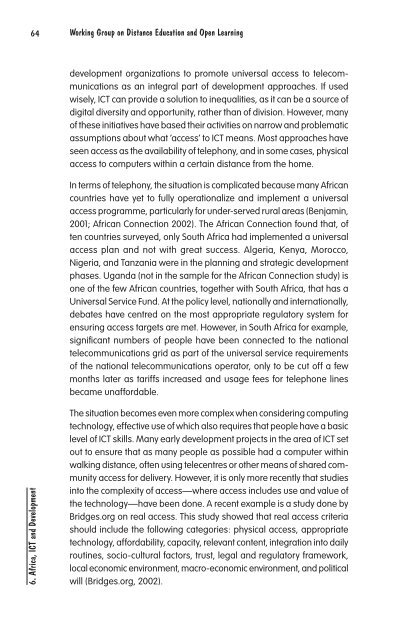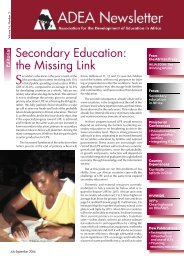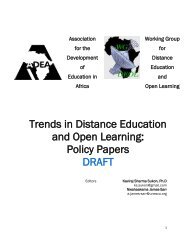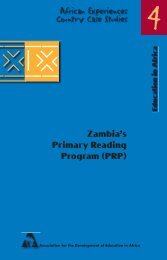Technological Infrastructure and Use of ICT in Education in ... - ADEA
Technological Infrastructure and Use of ICT in Education in ... - ADEA
Technological Infrastructure and Use of ICT in Education in ... - ADEA
Create successful ePaper yourself
Turn your PDF publications into a flip-book with our unique Google optimized e-Paper software.
64 Work<strong>in</strong>g Group on Distance <strong>Education</strong> <strong>and</strong> Open Learn<strong>in</strong>g<br />
development organizations to promote universal access to telecommunications<br />
as an <strong>in</strong>tegral part <strong>of</strong> development approaches. If used<br />
wisely, <strong>ICT</strong> can provide a solution to <strong>in</strong>equalities, as it can be a source <strong>of</strong><br />
digital diversity <strong>and</strong> opportunity, rather than <strong>of</strong> division. However, many<br />
<strong>of</strong> these <strong>in</strong>itiatives have based their activities on narrow <strong>and</strong> problematic<br />
assumptions about what ‘access’ to <strong>ICT</strong> means. Most approaches have<br />
seen access as the availability <strong>of</strong> telephony, <strong>and</strong> <strong>in</strong> some cases, physical<br />
access to computers with<strong>in</strong> a certa<strong>in</strong> distance from the home.<br />
In terms <strong>of</strong> telephony, the situation is complicated because many African<br />
countries have yet to fully operationalize <strong>and</strong> implement a universal<br />
access programme, particularly for under-served rural areas (Benjam<strong>in</strong>,<br />
2001; African Connection 2002). The African Connection found that, <strong>of</strong><br />
ten countries surveyed, only South Africa had implemented a universal<br />
access plan <strong>and</strong> not with great success. Algeria, Kenya, Morocco,<br />
Nigeria, <strong>and</strong> Tanzania were <strong>in</strong> the plann<strong>in</strong>g <strong>and</strong> strategic development<br />
phases. Ug<strong>and</strong>a (not <strong>in</strong> the sample for the African Connection study) is<br />
one <strong>of</strong> the few African countries, together with South Africa, that has a<br />
Universal Service Fund. At the policy level, nationally <strong>and</strong> <strong>in</strong>ternationally,<br />
debates have centred on the most appropriate regulatory system for<br />
ensur<strong>in</strong>g access targets are met. However, <strong>in</strong> South Africa for example,<br />
significant numbers <strong>of</strong> people have been connected to the national<br />
telecommunications grid as part <strong>of</strong> the universal service requirements<br />
<strong>of</strong> the national telecommunications operator, only to be cut <strong>of</strong>f a few<br />
months later as tariffs <strong>in</strong>creased <strong>and</strong> usage fees for telephone l<strong>in</strong>es<br />
became unaffordable.<br />
6. Africa, <strong>ICT</strong> <strong>and</strong> Development<br />
The situation becomes even more complex when consider<strong>in</strong>g comput<strong>in</strong>g<br />
technology, effective use <strong>of</strong> which also requires that people have a basic<br />
level <strong>of</strong> <strong>ICT</strong> skills. Many early development projects <strong>in</strong> the area <strong>of</strong> <strong>ICT</strong> set<br />
out to ensure that as many people as possible had a computer with<strong>in</strong><br />
walk<strong>in</strong>g distance, <strong>of</strong>ten us<strong>in</strong>g telecentres or other means <strong>of</strong> shared community<br />
access for delivery. However, it is only more recently that studies<br />
<strong>in</strong>to the complexity <strong>of</strong> access—where access <strong>in</strong>cludes use <strong>and</strong> value <strong>of</strong><br />
the technology—have been done. A recent example is a study done by<br />
Bridges.org on real access. This study showed that real access criteria<br />
should <strong>in</strong>clude the follow<strong>in</strong>g categories: physical access, appropriate<br />
technology, affordability, capacity, relevant content, <strong>in</strong>tegration <strong>in</strong>to daily<br />
rout<strong>in</strong>es, socio-cultural factors, trust, legal <strong>and</strong> regulatory framework,<br />
local economic environment, macro-economic environment, <strong>and</strong> political<br />
will (Bridges.org, 2002).

















